rocherougeEverything about migrating to France |
|
Home
Intro
Tips
Columns
Links
Contact (e-mail)
Friday, speptember 19, 2008
The French climate
One of the reasons why people say to emigrate to France is because of "the climate". For us, that was not thé utmost important reason, but it was one of the major reasons. The climate is quite different from what we expected. This is not due to France, nor the 'effet de serre’ (global warming), but the simple fact that we knew insufficiently how varied and often capricious the weather in France can be.
To inform all readers and prospective emigrants as best as possible we have made a summary of the explanations found on Meteorologic (to our opinion one of the better weather sites of France, at least if you can read French).
Furthermore, please respond with a story about the seasons in your own area in France (secondary or primary residence) > Click here to fill out your own climate description <. Responses will be added to the appropriate climate for other immigrants to share your experiences.
First of all, when do you arrive in France? Most probably in the summer. This it is not strange, because in the summer, large parts of France (as elsewhere in Europe) are not necessarily at its best but probably comfortable. Before we emigrated to France, we sometimes went to France in the winter. We have been to many different parts, from Honfleur to St. Flour to Le Vigan, but that winters in France could be real cold, we never realised. I always thought it strange that the village, where a few months earlier I had a seat on a terrace beneath a parasol sipping my café au lait, now welcomed me with cold shreds of dense mist. No leaves on the trees, no pétanque and no terraces. I recognize that same amazement with the visitors we have, they have difficulty understanding it rains here too.
France has many different climates, from the Mediterranean climate (hot and dry summers and mild winters) to the mountain climate (snowy and cold in winter).
What makes it so very difficult to understand for foreigners in France is that there are hundreds, if not thousands of microclimates (small areas with a different climate). That is something we don’t see in the Netherlands. Between the west (maritime climate) and the east (continental climate) there is a difference in temperature, but it is unthinkable that it rains for hours and hours in Rotterdam, while 10 miles onwards in Delft one can sit on a terrace in the sun. This is something you can expect in France, indeed.
To illustrate:
the city where we live (Espalion) is situated at the beginning of the highland in a valley, the temperature difference between Espalion and, for example Entraygues (pronounce: an-try-eu) 25 kilometers in the summer could be 5 degrees or more. It is said that in Entraygues the wind is more noticeable than here in Espalion. Sometimes we see that when Espalion is shrouded in mist, no more than 5 miles down the road the sun shines. And that’s just to name a few examples. The temperature difference between Espalion and Laguiole (pronounce: la-yawl), also 25 km away, is even more extreme. This can sometimes amount to a difference of 15 degrees! In spring and autumn it happens very often that a motorist is driving around here with a layer of snow on the roof, while 't is not snowing down here, we know immediately that they came either from Aubrac or Laguiole.
Below the main climates are discussed in detail.
Climates
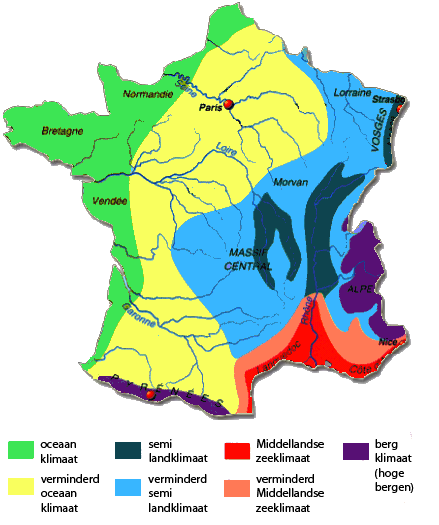
source: Meteorologic
Departments and regions
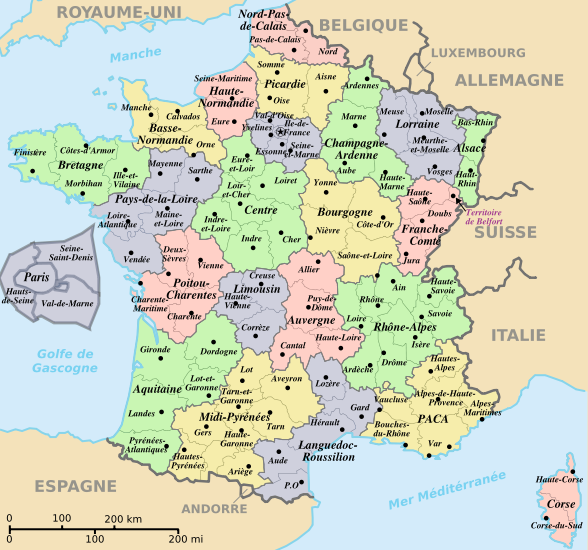
bron: wikipedia Départements de France
The main climates in France
- Mediterranean climate
- Oceanic climate
- Semi-oceanic climate
- Continental climate
- Mountain climate
The Mediterranean climate
This includes the regions east of the Pyrénées-Orientales (Eastern part of the Pyrenees), east and center of the Aude, a large part of the southern Hérault, Gard, Vaucluse, the extreme south of the Drôme, the Bouches-du-Rhone, the Var and the south of the Alpes Maritimes.
Characteristics:
This is an environment with great contrasts. There is a large temperature difference between summer and winter. The temperatures can drop to -20 °c, as happened in 1963, or over 40°c (in the shade) in the summer (heat record in France: 44.1 ° c in the Gard in August 2003).
The Mediterranean climate also has major differences in rainfall spread over the months of the year. There is six times more rain in October than on average in July.
How the weather is around the Mediterranean sea depends to a large extent on the wind direction. The north-easterly wind is notorious because of the dry cold brought in the winter and the warm and dry weather it carries in the summer. The southerly 'Marin', is notorious because of the sea fog (entrees maritimes), particularly in the Languedoc-Roussillon, and the warming of the seawater in the summer.
In this part of the Mediterranean every year many people drawn because swimmers are overtaken by the sea wind that suddenly rises and causes strong flows and high waves. These accidents happen less often at the Atlantic coast because people there are more aware of the changeable weather.
Example of a simplified diagram of the temperatures in the city Nimes.
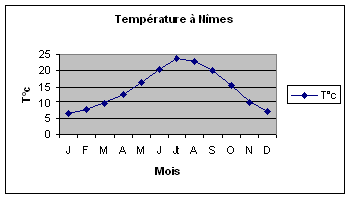
Our opinion:
I must say that this area (as far as I can perceive in the bulletins in the media) seems to have the most ideal climate. If there is sunshine somewhere, it is probably here. Keep in mind that the summers there are soaring hot, but you probably already knew that. The main disadvantage is that this area is extremely touristic. On the other hand, the beautiful weather, the lavender fields, the pine-trees and the sound of the cygales and the tourists are of course the ultimate summer experience.
The oceanic climate
This includes the regions Nord Pas de Calais, north and south Normandy, Brittany, the most western part of France, the Loire, the extreme west of the Centre region, west of Poitou-Charentes and the Aquitaine.
Characteristics:
The ocean climate, as the name says, is largely located against the Atlantic Ocean. The currents are mostly from west to east and regions are directly affected by the depressions above the ocean. It is impossible to capture this climate in one word. The ocean climate is erratic, with strong droughts, such as in the summer of 2003 (o well, where wasn’t it dry in France). On the other hand a significant amount of snow as seen in the last few winters, mainly in Normandy.
Temperatures are mild in the winter, but can also vary from one to another day. Especially along the coasts the temperatures in winter are moderate, but fresher when you move away from the coast (then the warm wind of the ocean has less influence).
In recent years, several times storms occurred, for example, the storm of December 1999 which has caused enormous damage with gusts of more than 150 kilometres per hour or the tornado of August 4 2008 when houses came down and three people were killed.
Example of a simplified diagram of the climate in the city of La Rochelle.
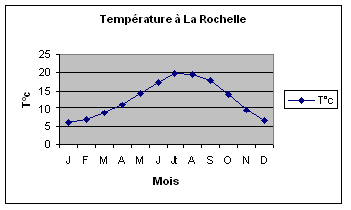
Our opinion:
From my own experience I can say that the climate in for example st. Jean de Luz is very different from the Mediterranean. But the summers are nice, however. If the weather is nice there it is beautiful, but if the sea nonsense with him then you're have difficulty keeping body and soul together, while in the rest of France beautiful weather can be.
Continental climate
This includes the regions: Alsace, Lorraine, Burgundy and Champagne-Ardenne.
Characteristics:
In a year there are very large temperature differences of -15 ° C in winter to 35 ° C in the summer. The difference between the coldest and warmest month is very big. Nevertheless, the rainfall stays moderate with an average of 600 mm. She falls in the form of snow in the winter and thunderstorms in the summer. The winter is long and tough with a large number frost days, but the summers are hot and with a lot of thunderstorms. The spring, however, is very short.
Unlike other climates, the French continental climate is characterized by wetter summers than those in autumn or winter. So you see in Strasbourg an average of 50 mm rainfall in the month of October compared with 75 mm rainfall in the month of July. The climate has also big differences in temperature and rainfall between the different heights.
Example of a simplified diagram of the climate in the city of Strasbourg.
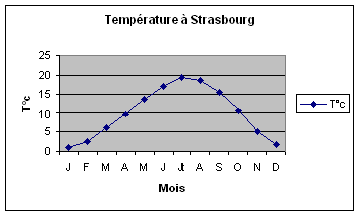
Our opinion:
This is the only area with which we have no experience. Who can tell me something about it?
Semi-oceanic climate
This includes the regions of Ile de France, Centre, west Limousin, Midi-Pyrénées.
Characteristics:
This climate, as the name says, is a combination of continental climate and oceanic climate, either, cold and dry periods in the winter or sometimes soft and moist. The regions in this area are sometimes under the influence of the Atlantic ocean but also under the influence of the climate.
The city of Paris for example, can be qualified as semi-oceanic climate: regular rainfall throughout the year, although that remains relatively weak in this region.
Example of a simplified diagram of the climate in the city of Paris.

Our opinion:
We live in a semi-oceanic climate and it is true, but here I can mention all sorts of details related to the specific climate in the north Aveyron. From the month September mornings here are the extremely cold and fog. The afternoons are quite warm, often rising to 25 degrees. From mid-November, it is really done with the fun, then it is winter. This winter lasts long, usually until early April and sometimes even longer. The spring I have never seen dry, really soaking wet. Summers are said to be very dry and hot and indeed it seemed to be so in the past months.
Mountain climate
This includes the regions of the Alps, the Pyrenees, the Jura, Vosges and the Central Massif.
Characteristics:
As the name suggests, this is a mountainous climate, either moderate summers and cold and snowy winters. The summers in the mountains are characterized by regular and intense thunderstorms in the evening and moderate temperatures. The winters are cold with many frost days. For information, the average temperature drops 1° Celcius every 160m higher. But snow also come to the earliest of which already fall on the highlands in the month of October.
Example of a simplified diagram of the climate on the Mont Aigoual.
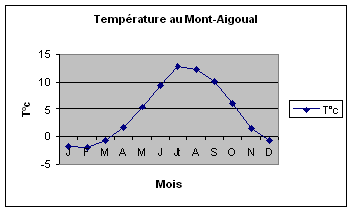
Our opinion:
we have often been at Mont Aigoual and can confirm this view. In the summer it can be warm, but never as hot as 1000 meters lower. A mountain climate (over 1200 meters almost) is severe. If you like snow, this is the ideal climate. As elsewhere spring has already started there’s still snow here. The mountain climate (apart from the cold) has many advantages: nature is often beautiful and unspoiled and according to the predictions, in the future many people will go to the mountains because the summer in lower areas is no longer bearable because of the heat. In addition, the housing prices (especially for old houses) are now even lower than in other parts of France.
![]()
posted by Ruud at 12:00 | send a comment
| Advertising on RocheRouge? Yes, that's a novelty. After having kept the site advertising free for five years, we decided to temporarily permit advertising as a test. Only under the dotted line. Thus you will know up to where the real information goes and where advertising starts. Did you like your visit to Roche Rouge, and have you found the information te be useful? Maybe you will find additional information when following the ad-links down here. Thank you ! | ||